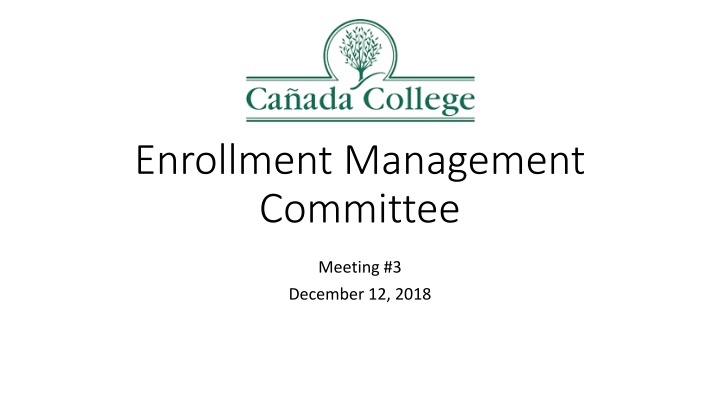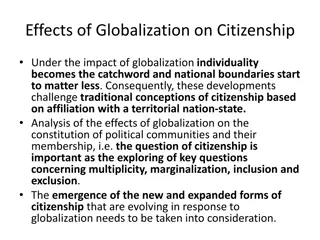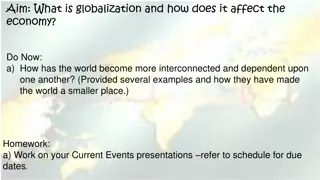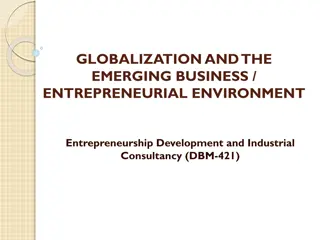
Globalization Challenges and Solutions
This content delves into the impacts of globalization on businesses, exploring challenges such as managing employee immigration, incurring tariffs, payroll complexities, and cultural identity loss. It also provides insights on strategies for effective global expansion, emphasizing the socio-political issues that governments and companies must navigate.
Uploaded on | 3 Views
Download Presentation

Please find below an Image/Link to download the presentation.
The content on the website is provided AS IS for your information and personal use only. It may not be sold, licensed, or shared on other websites without obtaining consent from the author. If you encounter any issues during the download, it is possible that the publisher has removed the file from their server.
You are allowed to download the files provided on this website for personal or commercial use, subject to the condition that they are used lawfully. All files are the property of their respective owners.
The content on the website is provided AS IS for your information and personal use only. It may not be sold, licensed, or shared on other websites without obtaining consent from the author.
E N D
Presentation Transcript
Enrollment Management Committee Meeting #3 December 12, 2018
Agenda Item Discussion Lead Time Allotted Dr. Tammy Robinson, VPI Dr. Karen Engel, Dean of PRIE Review of SEM Committee Sharing data and progress on the ERM website. Meeting Schedule for spring 2019 Timeline 15 30 Dr. Char Perlas, VPSS Dr. Tammy Robinson, VPI Guided Pathways and Enrollment Management (see IEPI crosswalk) Compare current SEM strategies with Quality Focus Essay, I CAN Start Strong plan Compare SEM to other High Impact Practices SEM activities v. Guided Pathways activities 5 Dr. Karen Engel, Dean of PRIE Maintaining an Equity Lens Considering disaggregated distance education course success data 5 Dr. Karen Engel, Dean of PRIE All Other Data Requested Degrees or Certificates offered 100% online Enrollment patterns of concurrently enrolled high school students Next Steps & Items for Future Meetings All 5 ADJOURN
Meeting schedule for spring 2019 Every two weeks? Monday afternoons?
Strategic enrollment planning phases Strategic enrollment planning phases 1. Preparation 2. Identification of key performance indicators 3. Developing a comprehensive situation analysis (data compilation, research, the SEP dashboard, etc.) 4. Strategy identification 5. Action plan development (business plan for each potential strategy) 6. Strategy prioritization (mission-fit, ROI, likelihood of success) 7. Develop quantifiable goals and a funding strategy 8. Execution, evaluation, and modification
Strategic enrollment planning phases Strategic enrollment planning phases 1. Preparation 2. Identification of key performance indicators 3. Developing a comprehensive situation analysis (data compilation, research, the SEP dashboard, etc.) 4. Strategy identification 5. Action plan development (business plan for each potential strategy) 6. Strategy prioritization (mission-fit, ROI, likelihood of success) 7. Develop quantifiable goals and a funding strategy 8. Execution, evaluation, and modification First Draft complete Evolving Dashboard? SEM and Guided Pathways Strategies and Actions
Timeline Finalize on- going SEM processes (data monitoring, evaluation) Revise Plan with ROI metrics Data dashboard Clarify details or each strategy Begin implementation where possible Fall 2018 Spring 2019 Fall 2019 Spring 2020 Updated data and SEP Identified team New SEM Plan
ISER Quality Focus Essay: I CAN Start Strong
Objective Activities Timeline Responsible Person(s) Guided Pathway Teams: Ca ada Goal 1. Student Completion/Success Inquiry Phase Fall 2018 Identify Strategy - Summer 2019 Implementation Fall 2019 and Spring 2020 Collection and Data Analysis Spring 2021 Increase by at least 20 percent the number of Ca ada students annually who acquire associates degrees, credentials, certificates, or specific skill sets that prepare them for an in-demand job. Complete-ability Increased accuracy of Student Education Plans which can inform course scheduling Grouping degree programs into Interest Areas or Meta Majors Optimization of the class schedule to avoid class cancelations and conflicts Alignment of support services with interest areas 1. 2. 3. 4. Academic Pathways Student Voices Business Process Analysis Steering Group Inquiry Phase Fall 2018 Identify Strategy - Summer 2019 Implementation Fall 2019 and Spring 2020 Collection and Data Analysis Spring 2021 Implementation/expansion of various high school engagement strategies: Dual Enrollment, Summer Programs, Outreach Events, etc Modification of the current Priority Enrollment Program (PEP) to better serve incoming students Expansion of cohorts via learning communities Expansion of Support and Instructional Programs Increase by 35 percent the number of Ca ada students transferring annually to a UC or CSU. Guided Pathway Teams: 1. Student Completion/Succes 1. 2. 3. 4. Academic Pathways Student Voices Business Process Analysis Steering Group Inquiry Phase Fall 2018 Identify Strategy - Summer 2019 Implementation Fall 2019 and Spring 2020 Collection and Data Analysis Spring 2021 Decreased by at least 1.1 percent the average number of units accumulated by Ca ada students earning associate s degrees (at Ca ada this would be represented by a decrease from 112 units to 101 units). Guided Pathway Teams: 1. Student Completion/Success Complete-ability Increased accuracy of Student Education Plans which can inform course scheduling Grouping degree programs into Interest Areas or Meta Majors Optimization of the class schedule to avoid class cancelations and conflicts Alignment of support services with interest area. 1. 2. 3. 4. Academic Pathways Student Voices Business Process Analysis Steering Group And 3. Organizational Development Inquiry Phase Fall 2018 Identify Strategy - Summer 2019 Implementation Fall 2019 and Spring 2020 Collection and Data Analysis Spring 2021 Increased the percent of exiting CTE students who report being employed in their field of study, from the most recent statewide average of 60 percent to an improved rate of 69 percent the average among the quintile of colleges showing the strongest performance on this measure. Guided Pathway Teams: 1. Student Completion/Success Expansion of Support (including Job Placement and Career assistance) and Instructional Programs Identification of job placement data tool 1. 2. 3. 4. Academic Pathways Student Voices Business Process Analysis Steering Group 2. Community Connections 3. Organizational Development Inquiry Phase Fall 2018 Identify Strategy - Summer 2019 Implementation Fall 2019 and Spring 2020 Collection and Data Analysis Spring 2021 Reduced equity gaps across all of the above measures through faster improvements among traditionally underrepresented student groups, with the goal of cutting achievement gaps by 40 percent within 5 years and fully closing those achievement gaps within 10 years. Guided Pathway Teams: 1. Student Completion/Success Streamlining the application process Proactive Registration Modification of the current Priority Enrollment Program (PEP) to better serve incoming students Providing the needed support for FAFSA completion Development of a First Year Experience program (Bridge Progs) Expansion of cohorts via learning communities 1. 2. 3. 4. Academic Pathways Student Voices Business Process Analysis Steering Group 2. Community Connections 3. Organizational Development
Objective Activities Timeline Responsible Person(s) Guided Pathway Teams: Ca ada Goal 1. Student Completion/Success Inquiry Phase Fall 2018 Identify Strategy - Summer 2019 Implementation Fall 2019 and Spring 2020 Collection and Data Analysis Spring 2021 Increase by at least 20 percent the number of Ca ada students annually who acquire associates degrees, credentials, certificates, or specific skill sets that prepare them for an in-demand job. Complete-ability Increased accuracy of Student Education Plans which can inform course scheduling Grouping degree programs into Interest Areas or Meta Majors Optimization of the class schedule to avoid class cancelations and conflicts Alignment of support services with interest areas 1. 2. 3. 4. Academic Pathways Student Voices Business Process Analysis Steering Group Inquiry Phase Fall 2018 Identify Strategy - Summer 2019 Implementation Fall 2019 and Spring 2020 Collection and Data Analysis Spring 2021 Implementation/expansion of various high school engagement strategies: Dual Enrollment, Summer Programs, Outreach Events, Middle College etc Modification of the current Priority Enrollment Program (PEP) to better serve incoming students Expansion of cohorts via learning communities Expansion of Support and Instructional Programs Increase by 35 percent the number of Ca ada students transferring annually to a UC or CSU. Guided Pathway Teams: 1. Student Completion/Succes 1. 2. 3. 4. Academic Pathways Student Voices Business Process Analysis Steering Group Inquiry Phase Fall 2018 Identify Strategy - Summer 2019 Implementation Fall 2019 and Spring 2020 Collection and Data Analysis Spring 2021 Decreased by at least 1.1 percent the average number of units accumulated by Ca ada students earning associate s degrees (at Ca ada this would be represented by a decrease from 112 units to 101 units). Guided Pathway Teams: 1. Student Completion/Success Increase % of first-time students completing transfer-level English, math and ESL in one year. Increased accuracy of Student Education Plans which can inform course scheduling Grouping degree programs into Interest Areas or Meta Majors Optimization of the class schedule to avoid class cancelations and conflicts Alignment of support services with interest area. Expansion of Support (including Job Placement and Career exploration assistance) and Instructional Programs Identification of job placement data tool 1. 2. 3. 4. Academic Pathways Student Voices Business Process Analysis Steering Group And 3. Organizational Development Inquiry Phase Fall 2018 Identify Strategy - Summer 2019 Implementation Fall 2019 and Spring 2020 Collection and Data Analysis Spring 2021 Increase the % of exiting CTE students who report being employed in their field of study, from the most recent statewide average of 60 percent to an improved rate of 69 percent the average among the quintile of colleges showing the strongest performance on this measure. Guided Pathway Teams: 1. Student Completion/Success 1. 2. 3. 4. Academic Pathways Student Voices Business Process Analysis Steering Group 2. Community Connections 3. Organizational Development Inquiry Phase Fall 2018 Identify Strategy - Summer 2019 Implementation Fall 2019 and Spring 2020 Collection and Data Analysis Spring 2021 Reduced equity gaps across all of the above measures through faster improvements among traditionally underrepresented student groups, with the goal of cutting achievement gaps by 40 percent within 5 years and fully closing those achievement gaps within 10 years. Guided Pathway Teams: 1. Student Completion/Success Streamlining the application process Proactive Registration Expand the College for Working Adults & Promise Scholars progs Providing the needed support for FAFSA completion Development of a First Year Experience program (Bridge Progs) Expansion of cohorts via learning communities 1. 2. 3. 4. Academic Pathways Student Voices Business Process Analysis Steering Group 2. Community Connections 3. Organizational Development
Missing strategies? Marketing Increasing the number of international students Monitoring all data (disaggregated) Student success or sampler courses Supplemental instruction (and Writing Center) plans Alerts and interventions Success Teams?
Areas for Enrollment Management Committee focus?
Fall 2017 Course Success Rates by Race/Ethnicity: Online v. Face to Face 90.0% 83.2% 80.4% 76.9% 76.6% 80.0% 73.9% 70.8% 69.0% 68.2% 67.1% 67.0% 70.0% 65.3% 63.6% 61.6% 60.8% 58.1% 57.0% 56.7% 60.0% 47.4% 50.0% 40.0% 30.0% 20.0% 20.0% 10.0% 0.0% 100% online Face to Face
Impact of online enrollments: Online only students (headcount) 1200 1000 800 600 400 200 0 2012 2013 2014 2015 2016 2017
Impact of online enrollments: FTES 2500 23% Online or Hybrid 2000 1500 1000 500 0 2012 2013 2014 2015 2016 2017 FACE TO FACE TOTAL ONLINE TOTAL HYBRID TOTAL
100% online degrees and certificates
AA Degrees that could be taken 100% online Anthropology (0) Economics (34) History (2) Political Science (4) Psychology, including AA-T (28) Interdisciplinary Studies: Social and Behavioral Sciences (69 for all IS) Interdisciplinary Studies with Transfer: Social & Behavioral Sciences Interdisciplinary Studies: Natural Science and Mathematics Interdisciplinary Studies with Transfer: Natural Science and Mathematics New: Business Administration Certificate (19 units) Per ACCJC Substantive Change Memo, 2014
2018-19 high school students concurrently enrolled by subject Canada as primary campus; enrollments at any campus 250 216 200 150 131 100 61 55 49464442383735 35322726252321 212016 161514 1410 9 9 8 50 6 6 5 4 3 3 2 2 2 2 2 2 2 2 1 1 1 1 1 1 1 1 1 1 1 1 0 SOCI CIS MUS. BUS. COUN INTD BIOL ASTR DRAM SPAN LIBR COOP CHIN FASH HSCI PLSC COMM KINE ASL CBOT LING ART MART ECE. PHIL PHYS BTEC WELL FITN LIT. DANC GEOG ACTG ADMJ ESL LEGL ENVS MEDA MGMT ECON ENGL ENGR DGME INDV PSYC ANTH CHEM OCEN METE LCTR MATH R.E. HIST CRER TEAM
Concurrently Enrolled High School Students 2018-19 61, 5% 138, 12% Canada CSM Skyline 951, 83%
How much do Caada students work? How much Canada students who attend less than full time work for pay during a typical, 7-day week How much Canada students who attend full time work for pay during a typical, 7-day week More than 30 hours, 17% None, 17% None, 24% 1-5 hours, 5% More than 30 hours, 39% 21-30 hours, 18% 6-10 hours, 8% 1-5 hours, 7% 11-20 hours, 12% 11-20 hours, 23% 6-10 hours, 11% 21-30 hours, 20% Source: CCSSE Survey 2015






















